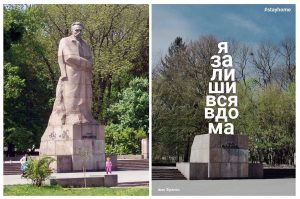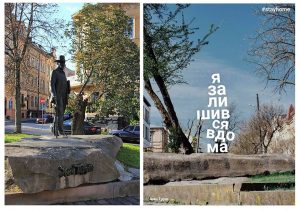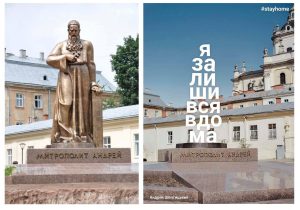Ivan Ischenko of Lviv has created a series of photos devoted to monuments of famous historical and cultural figures located in the city of Lviv. The message is simple, but clear: #Istayed_home (я залишився/залишилася вдома), in other words #stay_home!
Let’s take a look at who has gone home!
Taras Shevchenko, born March 9, 1814 in Moryntsi, Kyiv Governate, died March 10, 1861 in Saint Petersburg, Russia. Ukraine’s national bard and famous artist, poet, writer, public and political figure, as well as folklorist and ethnographer, inspiring Ukrainians throughout the ages. His literary heritage is regarded to be the foundation of modern Ukrainian literature and, to a large extent, the modern Ukrainian language. The monument to Taras Shevchenko is located on Prospekt Svobody.

Mykhailo Hrushevsky,
born September 29, 1866 in Kholm, died November 25, 1934 in Kislovodsk, Northern Caucasian Krai, RSFSR. Distinguished Ukrainian historian, prominent civic and political leader, publicist and writer, member of the Shevchenko Scientific Society from 1894, the Ukrainian Academy of Sciences from 1923, and the USSR Academy of Sciences from 1929. One of the most important figures of the Ukrainian national revival of the early 20th century, he led the pre-revolution Ukrainian national movement and presided the Central Rada (Ukraine's 1917-1918 parliament). The monument to Mykhailo Hrushevsky is located at the end of Shevchenko Avenue.

Ivan Franko, born August 27, 1856 in Nahuievychi, Lviv Oblast, died May 28, 1916 in Lviv. Writer, scholar, political and civic leader, publicist, poet, journalist, interpreter, political activist, and ethnographer, he wrote the first Ukrainian detective novels and published modern poetry in the Ukrainian language. The monument to Ivan Franko is located on Universytetska Street, before the Ivan Franko University of Lviv.

Ivan Trush, born January 17, 1869 in Vysotske, Lviv Oblast, died March 22, 1941 in Lviv. Impressionist painter, community figure, and art and literary critic, he founded and organized the first professional art societies in Halychyna (Galicia), the Society for the Development of Rus Art (1898), the Society of Friends of Ukrainian Art
(1905) and the first exhibition of Ukrainian artists, which drew participation from Kyiv-based artists. The monument to Ivan Trush is located at 108 Ivana Franka Street.

Danylo Halytsky (1201-1264) was King of Rus, ruler of the Galicia-Volyn Principality, Prince of Galicia (Halych), Peremyshl and Volodymyr . He was crowned by a papal archbishop in Dorohochyn in 1253 as the first King of Rus. The Galicia-Volyn state existed for over a century, and extended its power over most lands of present-day Ukraine. It owed its success and vitality to the outstanding personality of King Danylo. The monument to Danylo Halytsky is located on Halytska Square.

Ivan Fedorov, born ca 1525 in the Grand Duchy of Moscow, died December 16, 1583 in Lviv, was the founder of book printing and book publishing in Ukraine and Russia. He moved to Lviv in 1572 and resumed his work as a printer at St. Onuphrius Monastery. In 1574, Fedorov, with the help of his son and Hryn Ivanovych of Zabłudów, published the Apostolos and an Azbuka (Alphabet book). The monument to Ivan Fedorow is located in Pidvalna Street.

Adam Bernard Mickiewicz, born December 24, 1798, died November 26, 1855, was a Polish poet, dramatist, essayist, publicist, translator, professor of Slavic literature, and political activist. A prominent figure in Polish Romanticism, he is widely regarded as Poland’s greatest poet. Officially inaugurated on October 30, 1904, the monument to Adam Mickiewicz is located on Mitskevych Square. Adam Mickiewicz stands at the foot of the column; a winged Genius of Poetry hands a lyre to the poet. A large torch “burns” at the top of the 21-metre column.

Andrey Sheptytsky, born July 29, 1865 in Prylbychi, Lviv Oblast, died November 1, 1944 in Lviv. An influential religious, cultural and civic figure, Sheptytsky was the Metropolitan Archbishop of the Ukrainian Greek Catholic Church from 1901 until his death in 1944. The monument to Metropolitan Andrey Sheptytsky stands on St. George Cathedral Square, before St. George Cathedral.

The statue of St. George the Dragon Slayer
stands on Hryhorenka Square, before the Central Office of the Police. Erected in 1999, it is dedicated to the policemen of Lviv who lost their lives in the line of duty. In Ukrainian tradition, St. George was also the patron of Kyivan Rus, Halychyna (Galicia), the city of Lviv, the Ukrainian Cossacks, and the Ukrainian Army.

The statue of Mary, Mother of God and fountain stand near Mitskevych Square. The sculpture was commissioned by Countess Seweryna Badeni; it was sculpted in white marble by Johann Nepomuk Hautmann from Munich in 1859, and brought to Lviv the same year. In Soviet times, the sculpture was removed and placed in the Boim Chapel and subsequently to St. Andrew’s Church, and the fountain was topped with a vase. The original composition, including a copy of the original sculpture, was reconstructed in 1997.

The statues of Neptune and Adonis are located in Rynok Square, the heart of the historic city centre. The sculptures are two of four representing prominent mythological figures: Neptune (god of the sea), Diana (goddess of wild animals and the hunt), Amphitrite (goddess of the sea) and Adonis (god of beauty and desire). The four sculptures stand over fountains-wells from 1793, and were probably designed by Hartman Witwer, Lviv sculptor of Austrian descent.


#stay_home photos: Ivan Ischenko
Photo collage: Olena Makarenko





